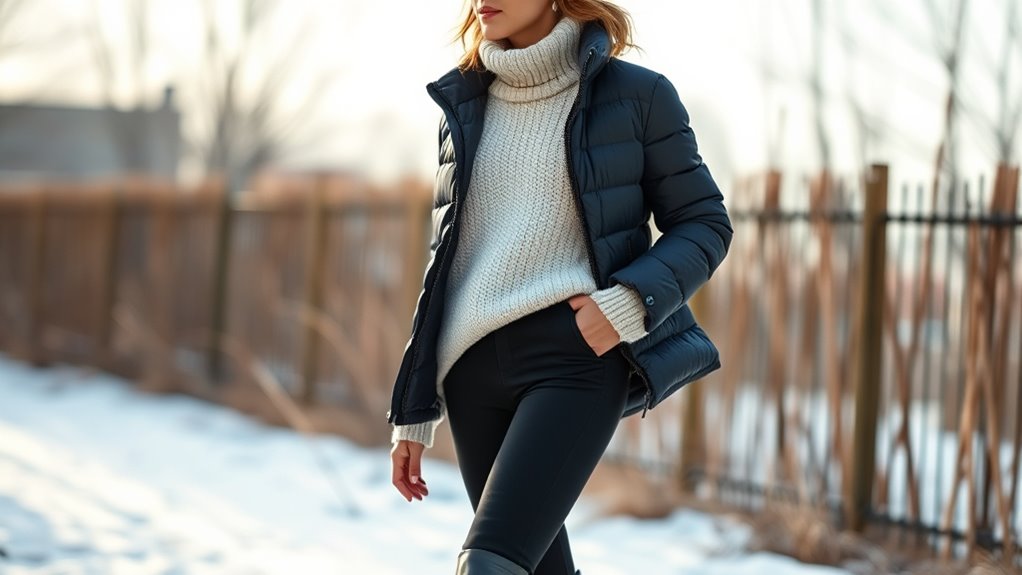To layer like a pro without bulk, start with a snug, moisture-wicking base layer made from lightweight merino wool or synthetic fabrics that keep you dry and cozy. Add a thin insulating middle layer like fleece or down-lined tops for extra warmth. Finish with a sleek, waterproof, or windproof outer shell that protects against the elements. Balance your layers to stay warm and stylish, and explore smart accessories to enhance your look. Keep going to discover even more tips!
Key Takeaways
- Choose fitted base layers made from moisture-wicking fabrics like merino wool or synthetics to stay warm without bulk.
- Use lightweight insulating layers such as fleece or down-lined tops to add warmth while maintaining a sleek silhouette.
- Select stylish, slim-fitting outerwear that is waterproof or windproof to protect against elements without bulkiness.
- Incorporate accessories like scarves, hats, and gloves that enhance insulation and complement your overall layered look.
- Focus on high-insulation, lightweight fabrics and proper fit to balance warmth, comfort, and a polished appearance.

As temperatures drop, layering becomes essential to stay warm and comfortable during winter. You want to combine function with style, and understanding how to layer effectively is key. The goal is to maximize thermal insulation without adding bulk, so you stay cozy while maintaining a sleek look. Start with a snug, moisture-wicking base layer that fits close to your skin. This layer is your first line of defense against the cold, pulling away sweat and keeping your body dry. Choose materials like merino wool or synthetic fabrics designed for thermal insulation, which trap heat efficiently without feeling heavy. These fabrics also offer excellent fashion versatility, allowing you to mix and match with different pieces for various outfits.
Over your base, add a thin insulating layer—think lightweight fleece or down-lined tops—that boosts warmth without bulk. The idea is to create a layered barrier that traps air close to your body, providing insulation. When you pick this middle layer, consider its texture and color, so it complements your outerwear and fits seamlessly into your wardrobe. This way, you can switch up your look easily without sacrificing warmth. For your outer layer, opt for a stylish, waterproof or windproof jacket that can handle the elements. Modern winter jackets come with sleek designs that don’t look bulky, so you stay looking sharp even in severe weather. Many jackets are designed to be versatile, so you can wear them over casual or dressier outfits, giving you fashion versatility along with thermal efficiency.
You can also incorporate accessories like scarves, hats, and gloves to add extra insulation where needed, but choose pieces that blend well with your overall look. Layering smartly means you don’t need to overdo it; each piece should serve a purpose and contribute to your overall warmth and style. Remember, fitting your layers properly is essential—if they’re too tight, they’ll restrict movement and cut off circulation; too loose, and air won’t be trapped effectively. Balance is key to maintaining comfort and a polished appearance.
Additionally, selecting appropriate fabrics that combine lightweight properties with high insulation can help you achieve warmth without bulk. Ultimately, mastering winter layering involves choosing lightweight, thermal-insulating materials that can be combined in various ways for different looks. When you understand how to layer correctly, you’ll stay warm without feeling weighed down, all while showcasing your personal style. With the right pieces, you can navigate winter’s chill confidently, looking fashionable and feeling comfortable in every setting. Layering isn’t just about staying warm; it’s about creating a versatile wardrobe that adapts to any winter day with ease.
Frequently Asked Questions
How Do I Choose Breathable Fabrics for Winter Layers?
When choosing breathable fabrics for winter layers, you prioritize thermal comfort and fabric durability. Look for materials like merino wool or technical synthetics, which wick moisture and allow airflow while keeping you warm. Avoid heavy, non-breathable fabrics that trap heat and moisture. By selecting these breathable options, you stay comfortable, dry, and well-protected from cold, ensuring your layers work together efficiently without adding bulk.
Can Layering Help With Temperature Regulation During Outdoor Activities?
Think of layering as building a shield against winter’s chill. Yes, layering helps regulate your temperature during outdoor activities by trapping warm air close to your body. It also improves thermal insulation and moisture management, preventing sweat from cooling you down too fast. By adding or removing layers, you stay comfortable and dry, making outdoor adventures more enjoyable even in the cold. Your gear becomes your armor against winter’s harshness.
What Are Eco-Friendly Layering Options?
You’re looking for eco-friendly layering options, and sustainable materials are your best bet. Choose pieces made from organic cotton, recycled polyester, or hemp, which reduce environmental impact. Opt for eco-conscious brands committed to ethical practices and eco-friendly fabrics. These options help you stay warm while supporting sustainable fashion. By selecting eco-friendly layers, you not only stay comfortable but also contribute to a healthier planet.
How Do I Prevent Bulkiness With Multiple Layers?
Imagine you’re heading out on a chilly day and want warmth without bulk. To prevent this, focus on thermal insulation and strategic positioning of your layers. For example, wear a thin, moisture-wicking base layer close to your skin, add a snug thermal top, then a lightweight, insulated jacket. This method keeps heat in while avoiding bulky layers, allowing you to stay warm and mobile.
Are There Specific Layering Tips for Sensitive Skin?
When layering for sensitive skin, choose hypoallergenic fabrics like cotton or silk to prevent irritation. Opt for soothing textures that feel soft against your skin, avoiding rough or synthetic materials. Layer lightweight, breathable pieces and avoid tight fits, which can cause discomfort. Always wash new clothing before wearing to remove irritants. By selecting gentle fabrics and ensuring proper fit, you can stay warm without sacrificing comfort or risking skin reactions.
Conclusion
So, after all that layering advice, you’re basically a walking winter wonderland—practically invisible under all those clothes. Who knew staying warm could be so stylishly complicated? Just remember, layering like a pro means you’ve mastered the art of looking effortlessly cozy while feeling like the Michelin Man. But hey, at least you’ll be the best-dressed snowman around—just don’t forget where you hid your keys under all those layers! Stay warm, and enjoy the winter chaos!









